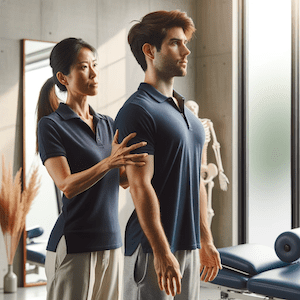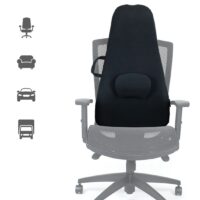Improving Posture
Enhancing Your Postural Health
Introduction
Posture profoundly impacts our daily lives, shaping our appearance, health, and functionality. This comprehensive guide delves into the importance of good posture, the risks of poor posture, and practical strategies for postural improvement, tailored for a general audience from a physiotherapist’s perspective.

Why Good Posture Matters
- Enhancing Strength and Flexibility: Proper posture distributes weight evenly, bolstering muscle strength and flexibility, enabling more efficient movement.
- Minimising Pain and Discomfort: Good posture can alleviate common issues like headaches, neck, shoulder, and lower back pain.
- Boosting Energy and Mood: An upright posture enhances circulation and oxygen flow, elevating energy levels and mood.
- Influencing Perception: Good posture conveys confidence and professionalism, positively impacting how others perceive you.
Risks of Poor Posture
- Neck Issues: Incorrect neck posture can lead to headaches and neck pain.
- Thoracic Complications: A hunched back may cause breathing difficulties, upper back pain, and a hunched appearance.
- Lumbar Concerns: Poor lower back posture can lead to lower back pain, sciatica, and increased spinal injury risk.
Understanding Ideal Posture
- Neck Alignment: The neck should form a gentle backward “C” shape, aligning ears over shoulders.
- Thoracic Curve: The spine’s middle curve should be a shallow forward “C” shape.
- Lumbar Positioning: The lower spine should maintain a gentle backward “C” shape.
Posture Assessment
A simple wall test can give a basic posture assessment, but remember, posture varies between individuals.
The Dynamic Nature of Posture
Flexibility is as crucial as stability. Regular movement is key to avoiding muscle fatigue and maintaining spinal health.
Posture Beyond the Spine
- Shoulders: Correcting forward-leaning shoulders can alleviate joint and nerve strain.
- Feet: Foot posture impacts overall body alignment. Maintaining natural foot arches is essential.
Enhancing Your Posture
- Education: Learn about proper posture and its key components.
- Strength and Flexibility: Strengthen core, back, and shoulder muscles; practice regular stretching.
- Awareness and Adjustment: Regularly monitor and adjust your posture throughout the day.
- Professional Guidance: Seek advice from a physiotherapist for severe posture issues or chronic pain.
Conclusion
Improving posture is an ongoing process that enhances your quality of life. Start your journey today and reap the long-term benefits of better health and comfort.
What to Do?
If you’re experiencing posture-related issues or want to learn more about improving your posture, please consult a physiotherapist.




















